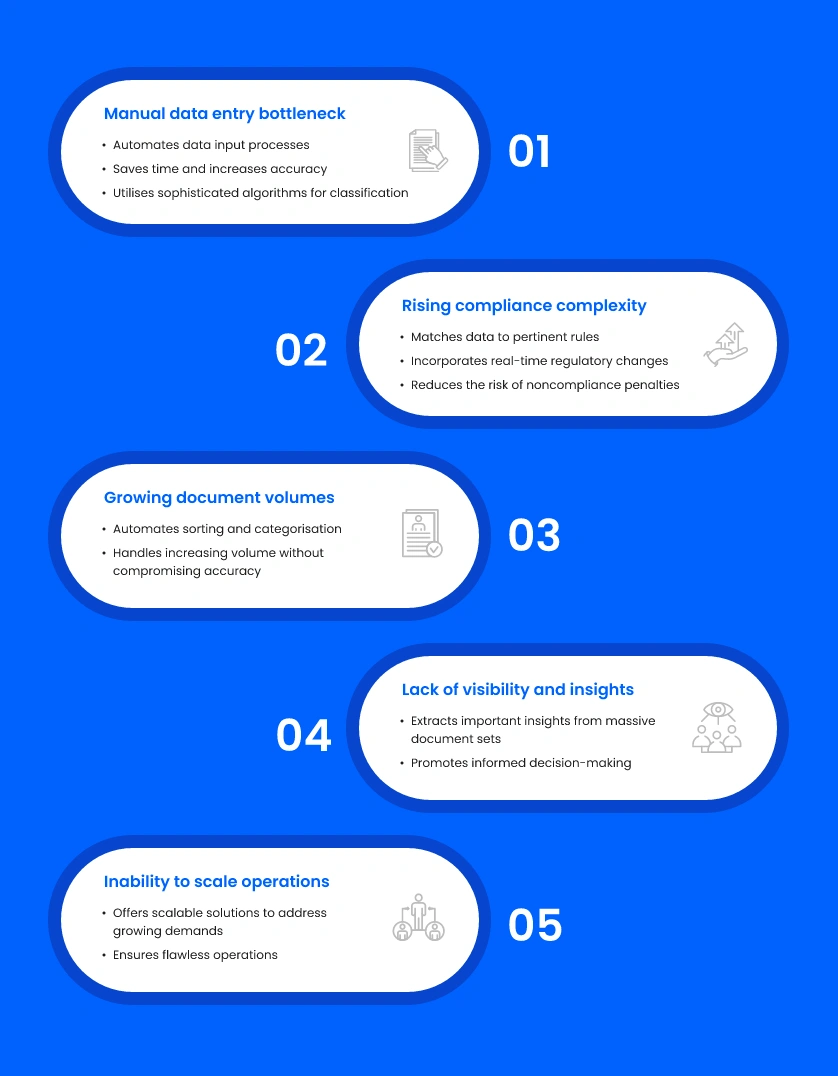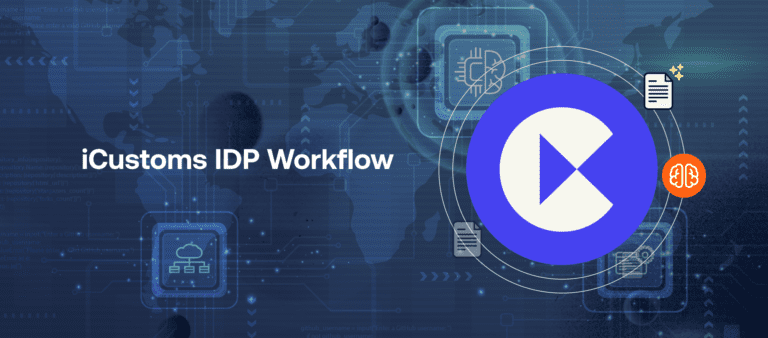Fast & Accurate ENS GB & EU ICS2 Solutions Built for You.
5 Signs Your Customs Business Needs Document Classification
-
Freya Jane
- Director of Customer's Success
In the modern, interconnected global economy, handling customs declarations has grown to be a crucial yet challenging duty for businesses that trade internationally. Navigating through customs paperwork manually not only takes up valuable time but also increases the chance of mistakes and compliance problems. Every cargo needs to be carefully planned, so any oversight or error in the customs declarations, particularly document classification, can result in expensive delays and penalties.
Thankfully, innovations in technology have opened the door for creative ways to expedite the customs clearance process. In this context, intelligent document processing and document classification are potent techniques that use machine learning and artificial intelligence to automate the structuring and categorisation of customs documents.
A 2016 Thomson Reuters/KPMG poll states that 95% of the respondents said they had trouble classifying HS codes, which caused mistakes and delays.
Businesses may reduce the risks involved with human data input, guarantee compliance with constantly changing rules, and ultimately improve the efficiency of their international trade operations by employing document automation.
Five signs your customs business needs document classification

Manual data entry bottleneck
The customs clearance procedure is still heavily reliant on entering data by hand, which presents problems with efficiency and accuracy. Moreover, it is labour-intensive, which slows down processes and increases the possibility of mistakes.
Recent studies have demonstrated the adverse effect of data input mistakes in customs declarations, which result in delays in shipment. Document classification is an important option for automating data input activities. It expedites the procedure, saving crucial time and guaranteeing increased accuracy by utilising sophisticated algorithms.
Furthermore, entering data by hand takes a lot of time and might result in errors. Human mistakes can result in inconsistencies in documentation, including typos and misinterpretations, which can delay customs clearance and perhaps damage the reputation of a business. The manual data entry procedure also frequently necessitates thorough manual cross-referencing and verification, which adds time to the clearance process.
This verification procedure is made more efficient by document classification, which automatically compares data to predetermined standards and legal requirements. By ensuring that all relevant data is appropriately recorded and complies with legal standards, this automatic validation speeds up the customs clearance procedure and lowers the possibility of errors or rejections.
Rising compliance complexity
The dynamic nature of customs laws is a continuous challenge for businesses that aim to remain compliant. The constantly changing circumstances increase the possibility of fines and delays in clearance resulting from incomplete or inaccurate disclosures. Automating documents turns out to be a crucial technique for managing this complexity. It strengthens compliance efforts by meticulously matching data to pertinent rules, reducing the possibility of expensive mistakes and guaranteeing conformity to strict criteria.
Furthermore, a lack of awareness or comprehension of changing customs requirements can make compliance difficult for businesses. It may be quite difficult to stay on top of legislative changes and make sure that operations are compliant in many jurisdictions, especially for businesses that lack a lot of resources or experience with customs issues.
This load is lessened by document classification, which incorporates automatically updated regulatory changes into the categorisation process. Businesses may reduce the risk of noncompliance penalties and ensure seamless customs clearing operations by adhering to the most recent laws in real time.
Read out to ensure customs compliance in 10 simple steps. Click here!
Growing document volumes
Businesses are dealing with more and more documents as global trade grows. Manual sorting and structuring of these large document collections is not only time-consuming but also error-prone. Document classification transforms this element by automating the organising and categorisation processes. It quickly processes and categorises documents using complex algorithms, allowing organisations to handle the increasing volume without compromising accuracy or efficiency.
In addition, the growing amount of paperwork increases the possibility of data loss or misplacing, making the procedure of clearing customs even more difficult. Manual document workflow management solutions are prone to mistakes and inconsistencies, resulting in missing or misfiled papers, which can cause delays and interruptions throughout the clearing process.
Furthermore, there are significant human and resource expenses associated with the manual sorting and processing of papers. Businesses must devote important human resources to managing an ever-increasing collection of papers, diverting resources and focus away from key business processes. Document categorisation automates document management operations, minimising the need for manual intervention and freeing up precious resources for strategic projects and business growth.
Lack of visibility and insights
Having access to practical insights obtained from data analysis is essential for streamlining customs procedures and promoting well-informed decision-making. However, successfully extracting important insights from massive document sets manually presents considerable hurdles.
This constraint is addressed by an automated documentation process, which takes relevant information out of documents. By providing firms with complete information, it enables informed decision-making, improves operational efficiency, and promotes strategic planning for future initiatives.
Moreover, businesses are unable to recognise inefficiencies and potential development areas due to a lack of insight into data analytics and customs procedures. The lack of clarity and granularity in manual data analysis makes it challenging to spot underlying patterns or trends in customs data. Furthermore, businesses may find it more difficult to proactively detect and manage hazards if they are unable to see inside customs procedures.
Businesses run the risk of missing possible operational inefficiencies or compliance problems if they lack thorough insights into customs data and procedures. This leaves them open to fines, delays, and interruptions. The legal document automation process improves visibility by giving real-time insights into data analytics and customs procedures. Businesses may mitigate possible risks and ensure seamless customs clearance operations by proactively identifying hazards and compliance concerns and taking proactive efforts to address them.
Inability to scale operations
Scaling operations in manual customs clearance procedures becomes challenging as businesses develop and struggle to adjust to rising demand. This struggle frequently results in delays and operational inefficiencies, which in turn jeopardise competitiveness and impede development opportunities.
Document categorisation offers a scalable solution to address the growing demands of enterprises. Even in times of fast development, its adaptability enables simple modification to changing requirements, guaranteeing flawless operations and sustained competitiveness. Businesses can keep up with the growing amount of customs paperwork and stay efficient and competitive in the global market by correctly classifying documents.
Experience the power of iCustoms’ IDP to simplify customs documentation. Start Now!
Simplify customs document classification with iCustoms
We at iCustoms are proud to present our innovative iClassification tool, which was created especially to expedite the customs procedure for document classification. Navigating the complexity of customs documents becomes simple with iClassification. Our modern software automatically sorts and categorises documents using sophisticated algorithms, guaranteeing adherence to legal requirements.
Through process automation, iClassification substantially reduces the amount of manual labour and lowers the possibility of mistakes and delays. With its smooth integration into current procedures, our technology helps customs businesses increase productivity, reduce turnaround times, and improve overall performance.
FAQ's
What is document automation?
Document automation refers to the use of software to expedite the generation, administration, and processing of customs documents.
What does the document automation process entail?
The process of document automation entails employing specialised software tools to automate the generation, storage, and distribution of documents, among other elements of document management.
How can I automate the documentation process?
You may use document automation software, which makes it easier to create, organise, and manage papers and automate the documentation process.
What is intelligent document processing software?
IDP software improves productivity and accuracy by automating document-related processes like extraction, categorisation, and validation. It does this by using cutting-edge technology like artificial intelligence and machine learning.
You may also like:
Struggling to Extract, Catagorise & Validate Your Documents?
Capture & Upload Data in Seconds with AI & Machine Learning
Subscribe to our Newsletter
About iCustoms
Struggling to Extract, Catagorise & Validate Your Documents?
Capture & Upload Data in Seconds with AI & Machine Learning

